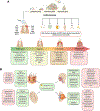A complete guide to human microbiomes: Body niches, transmission, development, dysbiosis, and restoration
- PMID: 38993286
- PMCID: PMC11238057
- DOI: 10.3389/fsysb.2022.951403
A complete guide to human microbiomes: Body niches, transmission, development, dysbiosis, and restoration
Abstract
Humans are supra-organisms co-evolved with microbial communities (Prokaryotic and Eukaryotic), named the microbiome. These microbiomes supply essential ecosystem services that play critical roles in human health. A loss of indigenous microbes through modern lifestyles leads to microbial extinctions, associated with many diseases and epidemics. This narrative review conforms a complete guide to the human holobiont-comprising the host and all its symbiont populations- summarizes the latest and most significant research findings in human microbiome. It pretends to be a comprehensive resource in the field, describing all human body niches and their dominant microbial taxa while discussing common perturbations on microbial homeostasis, impacts of urbanization and restoration and humanitarian efforts to preserve good microbes from extinction.
Keywords: body niches; dysbiosis; evolution; human microbiome; restoration.
Conflict of interest statement
Conflict of interest The authors declare that the research was conducted in the absence of any commercial or financial relationships that could be construed as a potential conflict of interest.
Figures





Similar articles
-
Human microbial ecology and the rising new medicine.Ann Transl Med. 2019 Jul;7(14):342. doi: 10.21037/atm.2019.06.56. Ann Transl Med. 2019. PMID: 31475212 Free PMC article. Review.
-
The sponge holobiont in a changing ocean: from microbes to ecosystems.Microbiome. 2018 Mar 9;6(1):46. doi: 10.1186/s40168-018-0428-1. Microbiome. 2018. PMID: 29523192 Free PMC article. Review.
-
Microbial Hub Taxa Link Host and Abiotic Factors to Plant Microbiome Variation.PLoS Biol. 2016 Jan 20;14(1):e1002352. doi: 10.1371/journal.pbio.1002352. eCollection 2016 Jan. PLoS Biol. 2016. PMID: 26788878 Free PMC article.
-
The Gills of Reef Fish Support a Distinct Microbiome Influenced by Host-Specific Factors.Appl Environ Microbiol. 2018 Apr 16;84(9):e00063-18. doi: 10.1128/AEM.00063-18. Print 2018 May 1. Appl Environ Microbiol. 2018. PMID: 29453266 Free PMC article.
-
From wolves to humans: oral microbiome resistance to transfer across mammalian hosts.mBio. 2024 Mar 13;15(3):e0334223. doi: 10.1128/mbio.03342-23. Epub 2024 Feb 1. mBio. 2024. PMID: 38299854 Free PMC article.
Cited by
-
Gut Microbiota and Parasite Dynamics in an Amazonian Community Undergoing Urbanization in Colombia.medRxiv [Preprint]. 2025 Apr 17:2025.04.16.25325921. doi: 10.1101/2025.04.16.25325921. medRxiv. 2025. PMID: 40321249 Free PMC article. Preprint.
-
StrainIQ: A Novel n-Gram-Based Method for Taxonomic Profiling of Human Microbiota at the Strain Level.Genes (Basel). 2023 Aug 18;14(8):1647. doi: 10.3390/genes14081647. Genes (Basel). 2023. PMID: 37628698 Free PMC article.
-
Exploring the Immunological Role of the Microbial Composition of the Appendix and the Associated Risks of Appendectomies.J Pers Med. 2025 Mar 14;15(3):112. doi: 10.3390/jpm15030112. J Pers Med. 2025. PMID: 40137428 Free PMC article. Review.
-
Microbiota-Host Interactions: Exploring Their Dynamics and Contributions to Human Diseases.Microbiologyopen. 2025 Aug;14(4):e70043. doi: 10.1002/mbo3.70043. Microbiologyopen. 2025. PMID: 40770906 Free PMC article. Review.
-
Ecological and evolutionary mechanisms driving within-patient emergence of antimicrobial resistance.Nat Rev Microbiol. 2024 Oct;22(10):650-665. doi: 10.1038/s41579-024-01041-1. Epub 2024 Apr 30. Nat Rev Microbiol. 2024. PMID: 38689039 Review.
References
-
- Aabed K, Bhat RS, Al-Dbass A, Moubayed N, Algahtani N, Merghani NM, et al. (2019). Bee pollen and propolis improve neuroinflammation and dysbiosis induced by propionic acid, a short chain fatty acid in a rodent model of autism. Lipids Health Dis. 18, 200. doi: 10.1186/s12944-019-1150-0 - DOI - PMC - PubMed
Grants and funding
LinkOut - more resources
Full Text Sources
